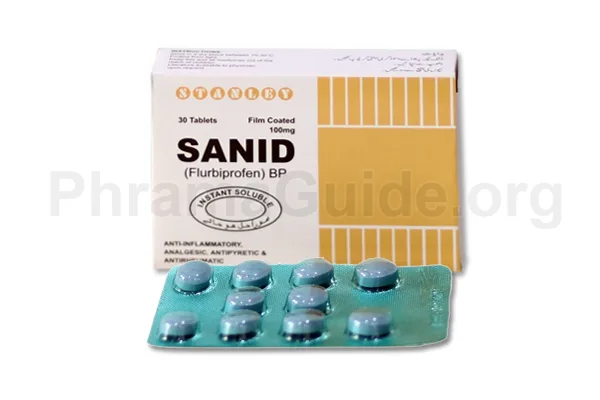Sanid tablet is a nonsteroidal anti-inflammatory drug (NSAID) that is primarily used for its analgesic and anti-inflammatory properties. Following are some common and off-label uses of Sanid Tablet:
- Pain Relief: Sanid is used to relieve mild to moderate pain, such as headaches, dental pain, menstrual cramps, muscle aches, and joint pain. It can be helpful in reducing pain associated with inflammation or injury.
- Inflammation Reduction: Sanid is effective in reducing inflammation caused by various conditions, including arthritis (such as rheumatoid arthritis and osteoarthritis), tendonitis, bursitis, and other inflammatory disorders. Using Sanid helps alleviate swelling, redness, and stiffness associated with these conditions.
- Postoperative Pain Management: Sanid may be used as part of a multimodal approach to managing postoperative pain after certain surgical procedures. It can help reduce pain and inflammation, promoting a more comfortable recovery.
- Dysmenorrhea: Sanid is sometimes used for the relief of primary dysmenorrhea (menstrual pain) in women. It can help reduce the intensity of menstrual cramps and relieve associated symptoms.
Off-label Uses of Sanid Tablet
- Migraine: Sanid may be used off-label for the treatment of migraines. It can help relieve the pain and inflammation associated with migraines, although there are other medications specifically approved for migraine treatment that may be more commonly prescribed.
- Dental Pain: Sanid may be used off-label for the relief of dental pain, such as toothaches or pain following dental procedures. It can help reduce pain and inflammation in the oral cavity.
- Sore Throat: Sanid lozenges may be used off-label for soothing sore throat symptoms. They can help relieve pain and inflammation in the throat, providing temporary relief.
- Temporomandibular Joint (TMJ) Disorders: Sanid may be used off-label to manage pain and inflammation associated with temporomandibular joint disorders. It can help reduce jaw pain and improve jaw movement.

What is Sanid?
Sanid is one of the leading brands of Flurbiprofen, manufactured and marketed by Stanley Pharmaceuticals (Pvt) Ltd, Pakistan.
Sanid Alternatives : Other Similar Brands
The following are Some Alternative Brands of Sanid and Their Manufacturers.
- Froben : Abbott Laboratories, Pakistan.
- Ansaid : Pfizer Laboratories (Pvt) Ltd.
- Synalgo : Platinum Pharmaceuticals (Pvt) Ltd.
- Biprofen : Martin Dow Pharmaceuticals (Pvt) Ltd.
- Dentifen : Macter International (Pvt) Ltd.
- Dol : Wilshire Laboratories (Pvt) Ltd.
- Dulpro : Global Pharmaceuticals.
- Vobifen : Novartis Pharma (Pvt) Ltd.
- Olgon : Himont Pharmaceuticals (Pvt) Ltd.
- Jasic : Libra Pharmaceuticals (Pvt) Ltd.
- Flurbin : Mass Pharma (Pvt) Ltd.
Sanid : Available Formulations and Strengths
Presently, Sanid is available in Tablet Form.
Sanid Tablet : 100mg strength.
Who Should Not Use Sanid?
Sanid has certain contraindications, which are medical conditions or situations where the use of Sanid is not recommended due to potential risks or adverse effects.
Allergic Reactions: Sanid should not be used by individuals who have a known hypersensitivity or allergic reaction to Sanid or other nonsteroidal anti-inflammatory drugs (NSAIDs). Allergic reactions to NSAIDs can range from mild symptoms such as rash and itching to severe reactions, including difficulty breathing or anaphylaxis.
Asthma, Nasal Polyps, and Aspirin Sensitivity: Sanid is contraindicated in individuals with a history of asthma, chronic rhinosinusitis with nasal polyps, or sensitivity to aspirin or other NSAIDs. These individuals may be at an increased risk of developing severe bronchospasm, asthma attacks, or allergic reactions upon using Sanid.
Active Peptic Ulcer Disease or Gastrointestinal Bleeding: Sanid should not be used in individuals with active peptic ulcer disease (ulcers in the stomach or duodenum) or a history of gastrointestinal bleeding. NSAIDs, including Sanid, can increase the risk of gastrointestinal ulcers, bleeding, and perforation.
Severe Kidney or Liver Dysfunction: Sanid is contraindicated in individuals with severe kidney or liver dysfunction. It is important to use caution in individuals with mild to moderate impairment of kidney or liver function, as Sanid can further impair the function of these organs.
Third Trimester of Pregnancy: Sanid should generally be avoided during the third trimester of pregnancy due to the potential risk of complications to the developing fetus, including premature closure of the ductus arteriosus (a blood vessel in the heart).
Preoperative Use for Coronary Artery Bypass Graft (CABG) Surgery: Sanid is contraindicated for use before or after CABG surgery, as it may increase the risk of cardiovascular events, including heart attack and stroke.
Children and Adolescents with Viral Infections: Sanid is contraindicated in children and adolescents with viral infections, particularly varicella (chickenpox) and influenza, due to the increased risk of developing Reye’s syndrome, a rare but serious condition affecting the liver and brain.
What is the Recommended Daily Dosage of Sanid?
Sanid Dose for Pain Relief:
- Initial Dose: One Tablet of 100mg daily.
- Followed Dose: One or a half Tablet of 100mg, every 4-6 hours as needed for pain relief.
- The maximum daily dose should not exceed 3 tablets of 100mg per day.
Sanid Dose for Arthritis:
- Initial Dose: 1 to 2 Tablets of 100mg daily.
- Followed Dose: 1 to 2 tablets of 100mg every 4-6 hours as needed for symptom relief.
- The maximum daily dose should not exceed 3 to 4 Tablets of 100mg.
Sanid Dose for Dysmenorrhea:
- Initial Dose: One Tablet of 100mg Daily.
- Followed Dose: One or a half Tablet of 100mg, every 4-6 hours as needed for pain relief.
- The maximum daily dose should not exceed 3 tablets of 100mg per day.
How Sanid Works?
Sanid works by inhibiting the activity of both COX-1 and COX-2 enzymes, although it has a higher affinity for COX-1. By inhibiting COX enzymes, Sanid reduces the conversion of arachidonic acid to prostaglandins. This leads to decreased production of prostaglandins, which results in the suppression of inflammation, alleviation of pain, and reduction of fever.

Leave A Comment